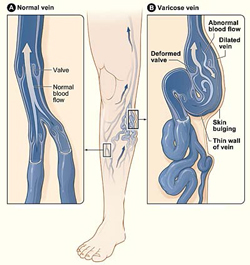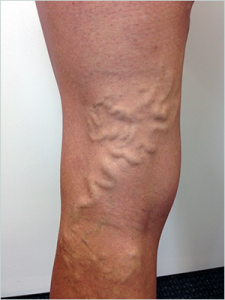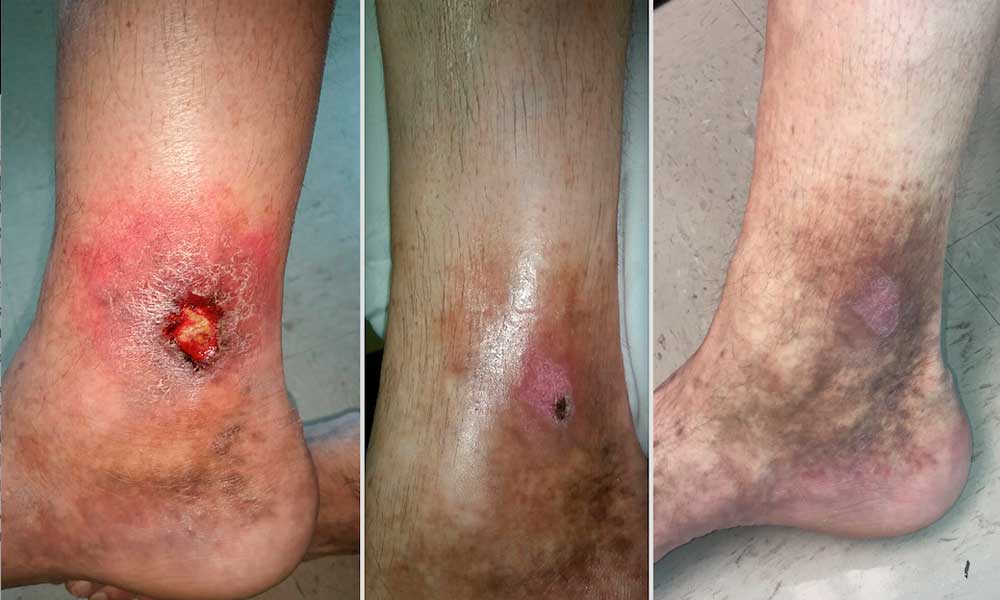What is Varicose Vein

The varicose vein consists of: – A. Venous insufficiency or venous reflux at groin B. Prominent and dilated perforators. C. Dilated tortuous side branches.
Varicose vein of legs is common, affecting 1-15% of adult men and 20-25% of adult women. The leg vein normally contains multiple valves which help the blood flow in direction of the heart. When these valves are damaged, blood starts pooling in the legs causing swelling of the legs, aching pain, heaviness, fatigue, skin discoloration, itching, varicosities (prominent vein) and if not treated it may develop non-healing ulcers in leg. Ultimately, the person is forced to lead a disabled life.
Symptoms of Varicose Veins
Comfortable and sedentary lifestyle, modern fashion, special postures adopted while performing professional duties have contributed to increased incidence of a set of diseases unheard of in the past.  Varicose vein disease is one of them and is a direct result of sedentary lifestyle. The problem has become very common during these days. According to one estimate, 15 to 20 percent of the population in India is suffering from varicose vein disease these days. Women suffer from this disease four times more than men. There is an increased risk of the development of varicose vein among young females who wear tight jeans and high-heeled sandals.
Varicose vein disease is one of them and is a direct result of sedentary lifestyle. The problem has become very common during these days. According to one estimate, 15 to 20 percent of the population in India is suffering from varicose vein disease these days. Women suffer from this disease four times more than men. There is an increased risk of the development of varicose vein among young females who wear tight jeans and high-heeled sandals.
- The most common presenting with symptoms:
- Pain on & off.
- Swelling more prominent at the end of the day.
- Heaviness in leg.
- Fatigue.
- Prominent & dilated veins in leg veins.
- Pigmentation.
- Venous ulcer
The causes
The important causative factors are obesity, lack of exercise, abnormal pressure on veins during pregnancy, prolonged standing and prolonged sitting with legs down. Due to advanced age, overweight and lack of exercise veins of legs become very weak and, therefore, develop into varicose veins.
Today a lot of occupations and professions have sprung up where a person is required to either constantly stand up for a long time or made to sit with legs hanging down for a considerable time. Computer professionals, receptionists, security guards, traffic policemen, salesmen working at counters in shops and departmental stores and persons doing desk jobs day in and day out are the worst sufferers of varicose veins.
Women are more susceptible to varicose veins?
Among females, due to some hormones, the walls of veins become weak causing vein to become enlarged and dilated. Besides, during pregnancy because of a lot of pressure on leg veins, these become weak and varicose. Fashion is playing havoc among women. High-heeled sandals and tight belts and panties are significant contributors to the development of varicose veins, as these items obstruct the normal flow of blood in the veins.
Side effects & complications
Bleeding from Superficial Veins – long-standing high pressure in the veins may develop an area that bleeds through small sites, no larger than pinholes. Most of these occur around the ankle, but spontaneous bleeding can also occur anywhere there is high venous pressure.
Venous pigmentation, also known as Hemosiderin staining of the skin is a relatively common late complication of untreated superficial chronic venous hypertension.
Venous stasis dermatitis, also known as venous eczema, is a common inflammatory skin disease that occurs on the lower extremities in patients with severe chronic venous congestion. It can arise as discrete patches or affect the leg all the way around the ankle. Symptoms of this condition include swelling (typically concentrated around the legs or ankles), changes in skin color and texture, and pain. The affected skin is itchy and assumes red, purple, or brown colors.
Venous stasis ulcers is the most serious complication of untreated superficial venous insufficiency and chronic venous congestion.
Superficial venous thrombosis is a blood clot, or thrombus, which develops in a vein close to the surface of the skin. The blood clot commonly appears as a red streak along the course of an affected vein, which may feel warm and tender or swollen due to inflammation (phlebitis).
Deep vein thrombosis (DVT) – occurs when a blood clot forms in the deep veins the leg. This occurs due to slow flow in the veins. Total occlusion of one or more of the major leg veins and the impaired blood return to the heart results in massive leg swelling.
Pulmonary embolism – blood clot formed in the deep veins of the body some time migrate to lungs causing pulmonary edema. It may even lead to death if not treated immediately.
Treatment options for Varicose Veins
- Non-surgical treatment by RFA (radiofrequency ablation or laser)
- Conservative Treatment: – Elevating and flexing your legs can help reduce leg swelling and relieve other symptoms. Compression Stockings: –Compression stockings are elastic stockings that squeeze your veins and stop excess blood from flowing backward. You may be required to wear compression stockings daily for the rest of your life.
- Sclerotherapy: – This is only for short segment disease.
- Vein Stripping Surgery: – It is a major surgery. Physician disconnects and ties off all major varicose vein branches associated with the saphenous vein, he then removes the saphenous vein and varicose veins from your leg surgically. The recurrence rate is too high and it leaves ugly scars. It needs 2-3 weeks for recovery.
Non-Surgical Treatment for Varicose Veins – Radio-frequency Ablation
Radiofrequency ablation (RFA) is the latest and most effective, patient-friendly and non-surgical treatment for varicose vein using Multipolar RFA machine. Under color-doppler ultrasound vision, a radiofrequency catheter is inserted into the abnormal vein and the vessel is treated with radio-energy, resulting in closure of the involved vein.
The interventional radiologists are uniquely skilled in using the vascular system to deliver targeted treatments throughout the body without surgery. He accesses the abnormal saphenous vein just above ankle or below the knee percutaneously through a small cannula in abnormal vein. Ablation uses a thin, flexible tube called a catheter with tiny electrodes at the tip of the catheter, which heat the walls of the varicose vein, and collapses the thick veins.
Advantages of Treatment with RFA
- It is less risky as compared to surgery.
- No surgical scar on skin.
- Procedure is done under short/local anesthesia.
- It is done as daycare or 24 hrs hospital stay.
- Patients can resume normal activities within a day.
- The recurrence rate is very low as compared to surgery.
